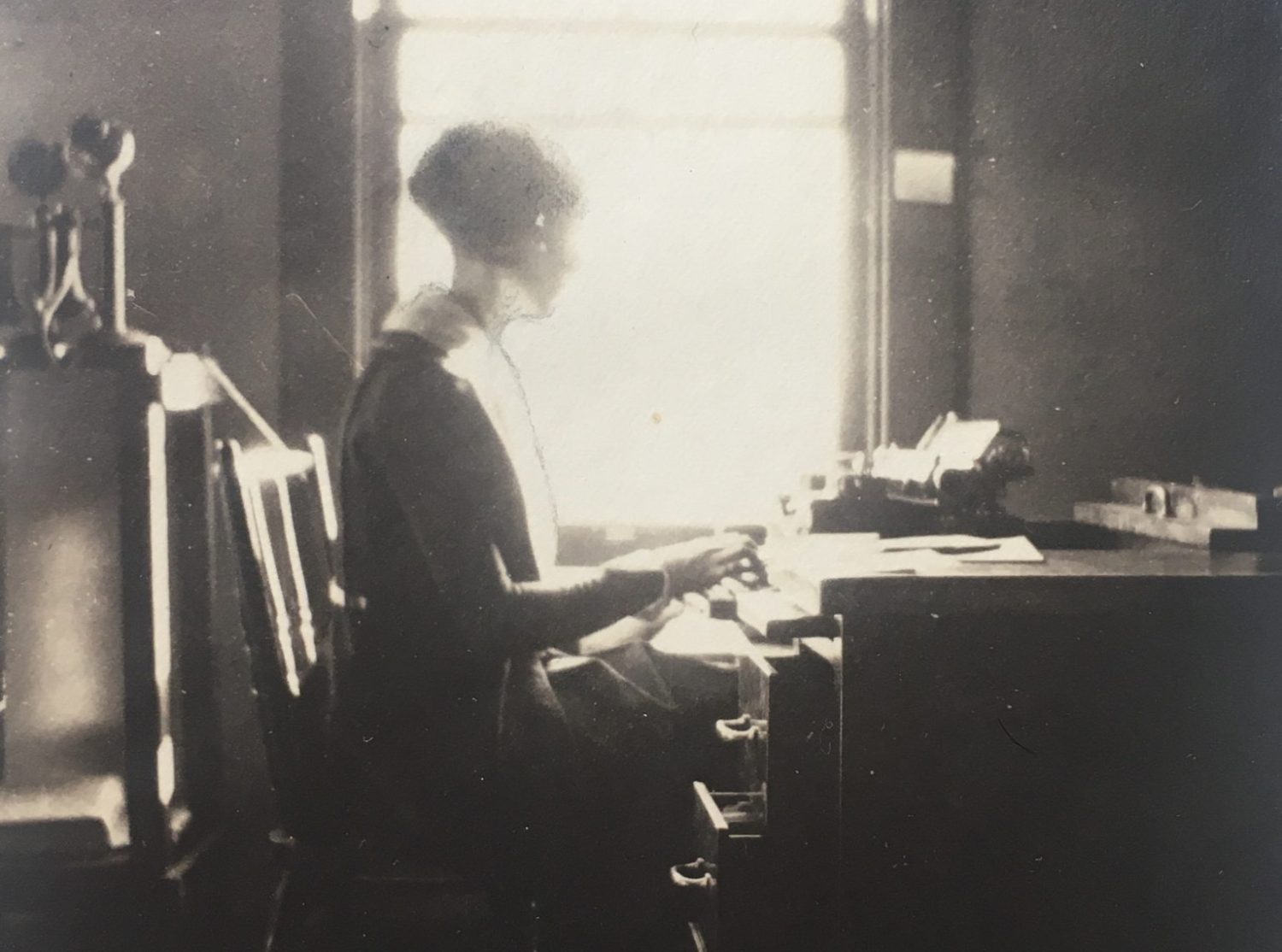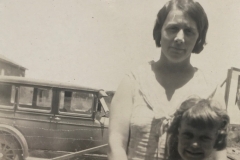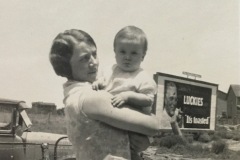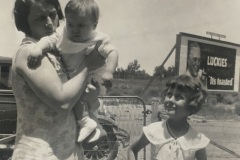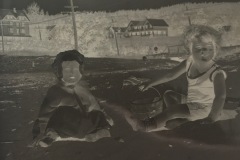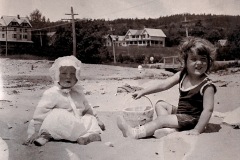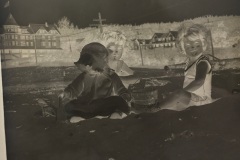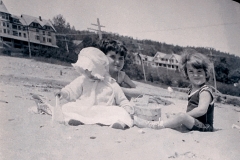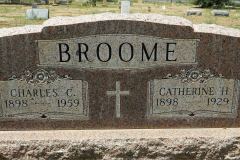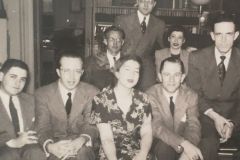Thank you for joining me for another write-up of my 2021 YouTube project: Another Thousand Letters. In Episode 11, Helen arrived in Albuquerque with a mission to visit with her family, especially her recently deceased sister’s two children. We’ll find out whether she returned to New York, working for Lowell Thomas, and a relationship with Charles Cooke?
If you prefer video, enjoy Episode 11 – For the Children.
Longcut Stop #5 of 6: Albuquerque, New Mexico
After the grueling and hot 3-day train trip from Memphis, Helen arrived in Albuquerque on her mission for the children. Her sister Elsie and Elsie’s children, Alice, from a prior marriage, and Lyman Junior, from her current marriage to Lyman Putney, met her at the train.
Elsie looks awfully well, has a much better figure, and Alice Frances is as pretty as ever. But you should just see Lyman Beecher. He is adorable… great big eyes the color of Elsie’s and is so chubby and healthy looking and he has such a naughty twinkly in his eyes. He is the brightest looking thing, understands every word you say, and just talks with his eyes. You’d be crazy about him, Mother.
“Monday” – Postmarked August 25, 1930 Letter from Helen Hemlin to her Mother, Katherine Hemlin
Given my guess that Lyman Junior is close to a year old in the picture below, some of which are labeled, I believe these pictures were likely taken by Helen during her 1930 visit.
Family Visits
You know that feeling of seeing someone you enjoy spending time with after a long separation? Seeing someone you’ve missed is even more cherished now as the pandemic forced and continues to force separations.
Every time I visited Dad and Arlene in Ohio, as soon as my last day approached, Arlene began a familiar script. “You know, you could just miss your flight and stay here. We wouldn’t mind.” It was so predictable, we’d giggle and laugh about me staying, each visit building more outlandish ideas of an imaginary life with me present more often. She knew it was a lost cause. The mountains would likely be my home for life. But, the script was part of our routine, her way of saying she loved me and wished I was closer more often.
That memory and the joy of those moments together is more valuable than more presence would have been. I considered that Helen might have felt similarly about New York in 1930 as I felt about my home being in the mountains. As I read her letters, I wondered if Helen was forming similar memories when she shared:
[Lyman and Elsie’s] feeling for me doesn’t seem to have changed any … Lyman said he wasn’t ever going to let me leave.
“Monday” – Postmarked August 25, 1930 Letter from Helen Hemlin to her Mother, Katherine Hemlin
I remember being ill only once while visiting Dad and Arlene. I had run a 50k organized by a high school friend, Jennifer, who had also gotten into ultra running. It was a grassy, loop course on which unavoidable puddles formed throughout the rainy afternoon. I allowed the closeness of aid to trick me into carelessness for my wet feet. They had also chilled and a big toe had become frost nipped. Arlene had become an R.N. later in her life; she inspected then treated the giant blister. I remembered Arlene’s care while reading Helen confide to her Mother and Erne how difficult the last part of her trip had been:
Well, as I say, I had this heavy cold…I was quite miserable, so piled into bed until I felt better. Poor Elsie, I always seem to come to her when I’m at my worst. But the trip really was quite strenuous. Anyway, I got up again after a day or two and just fine now.
“Monday” – Postmarked August 25, 1930 Letter from Helen Hemlin to her Mother, Katherine Hemlin
Longcut Final Stop #6 of 6: Santa Fe, New Mexico
But the primary goal of Helen’s visit was for the children. That is, to see the babies, Gloria and Junie, who were in Santa Fe with their father…and new step-mother Helen Broome.
I phoned Charles the day after I arrived and he said they would be down to see me that Sunday. He said Helen had to go to Indiana to see her sick mother and wanted me to stay with Charles and the babies while she was gone. Else and Lyman didn’t like for me to go off quite that soon but I’m going to stay with them all next month so they finally gave in.
On Sunday, Charles and Gloria came down to Bernalillo and spent the day with us and then took me on back to Santa Fe. Charles looks so much better than his pictures. And Gloria looks splendid, getting quite big, but very healthy looking.
“Monday” – Postmarked August 25, 1930 Letter from Helen Hemlin to her Mother, Katherine Hemlin
Bernalillo is about a 50-mile drive to Santa Fe. Helen was so busy during her two-week stay that it took an 8-page letter to her Mother and Aunt Erne to detail the events and share what looked like acts of acceptance for Cathrene’s death.
No Need to Worry: Helen Broome is Family
Whatever concerns Helen Hemlin and Mae Broome had for the children not going to Helen Broome if something happened to Charles, melted for Helen Hemlin within the first 24 hours meeting Helen Broome. Helen Hemlin wrote:
Mother Darling,
I’ve been all this time getting to this letter, but you see I have a family now and it isn’t quite so easy. I’ve been terribly happy here…Charles brought me up here two weeks ago …Helen… is a lovely person, older than Charles, of course…of a slight build, and dresses beautifully …charming and cultured and will be a wonderful mother to the babies.
She did not beam all over me when she saw me. I kissed her and she had Junie in her arms, and when I saw Junie I simply couldn’t speak. She is Catherine absolutely. I never saw such a likeness, and of course, was stunned. She came right to me as though she’d known me always.
The next day however, Helen thawed out and we became awfully good friends. I’m crazy about her and know she will do right by Charles and the babies.
Helen was called to Indiana because of her mother’s illness and wondered if I would stay with Charles and the children while she was away. That was the opportunity I’ve been waiting for.
I was thrilled to death. They have this lovely house here … and two cars so there wasn’t a thing for me to do but watch over everything and keep everybody happy.
And Mother, as long as I live I shall always be thankful for having made this trip.
August 1930 postmarked letter with “Saturday” noted on letter from Helen Hemlin to her Mother, Katherine Hemlin
And keeping Cathrene’s widow and her children happy is exactly what Helen did. I can’t imagine a better way to walk through acceptance.
For the Children – Finally
Helen Broome left for Indiana leaving Helen Hemlin to care for the babies for two weeks. Helen gushed to her Mother:
You would simply adore Junie. She is the most sweet tempered lovable youngster I have ever seen. She just runs all over the place. We are sending you some snapshots taken in her sunsuit. And she is so well trained, not a bit of fuss or bother…
Charles always says if only Grandma Hemlin could see the babies. And he has promised that I will be able to take them to New York as soon as she can stand the trip.
And Gloria is a big girl now…She was so thrilled with the things you sent her… I’ve been working every day with Gloria at the piano and she really is doing splendidly. She gets discouraged once in a while but I manage to talk her out of it. And last Monday was her first day of school and I had to get her registered and everything. Oh, I do make quite the mother.
August 1930 postmarked letter with “Saturday” noted on letter from Helen Hemlin to her Mother, Katherine Hemlin
I too had experienced Helen seeming to have little to do but focus on keeping me happy. On my summer visits, she created the environment that let me read books as if time stood still. I edited stories with her galleys, tape, and pencils – editor tools of the 1970s, long before word processors were available.
I agreed. Helen made quite the mother and I wished I had more pictures of her with me as well as with Gloria and Junie.
I believed I had found the pictures of Junie and Gloria in their sunsuits. Recalling negatives with what appeared to be children at a beach, I downloaded the Photomyne app and processed the negatives in seconds. Although these were not labeled, the timing, consultation with family members, and comparison to photos that are labeled led me to believe these are probably Junie and Gloria.
Healing from Catherine’s Death
Six pages into the letter, the trip appears to have resolved any concerns for the children and signs of grief acceptance of Cathrene’s death appeared.
Gloria and Charles say I am just so much like Cathrene that it seems almost like having her back again. And that alone has been worth my whole trip. Oh, I shall have lots to tell you when I see you and I know you will be happy with me.
For two weeks I’ve had my little family all to myself. In addition to that everybody in town has been inviting me to and giving parties for me… I begged Charles several times to let me stay home but he wants me to popular.
Charles and I have gone to the cemetery several times and he has the sweetest grave for Cathrene. Yesterday I bought a beautiful evergreen wreath and we hung it on the tombstone. It will last for months and I was happy to spend my last few dollars for that.
August 1930 postmarked letter with “Saturday” noted on letter from Helen Hemlin to her Mother, Katherine Hemlin
I have never held sentimentality for gravesites. Perhaps I am allowing myself to reflect more with this project. I searched for and found Cathrene’s gravestone. Perhaps it was customary for the tombstone to include Charles even though he remarried. I have another list: a dream plan for a trip to places relevant to the project. Visiting the Santa Fe Cemetery with an evergreen wreath is on the list.
Money
Although Helen felt her trip for the children and family was worth every penny she spent of her money, she was running out of it. And, it is possible that Helen’s Mother, a widow since 1917, depended in part on funds from Helen’s job with Lowell Thomas to survive. She asked her mother to draw money from the bank if needed until she could get a job in Albuquerque.
And that reminds me Mother. Could you possibly manage just a little longer without my money? You could draw it from the bank, couldn’t you, if you needed to. Gee, please, Mother, for I have only a few cents left. This trip has cost a terrible amount of money, but it’s been worth it. It will probably be a long time before I can do as much for my whole family and I have done this for all of you because I love you all so much, and you will be happy too when I tell you everything after I get back.
You see, Mother, on Monday, Charles is taking me back to Albuquerque and I am going to immediately try to get a job. And as soon as I get straightened out I will send yours on to you. Do you mind, Mother? Please help me this much this time, for I’ve given every bit I had to make the trip … Anyway, I’ll send it to you as soon as I make it if you can just manage until then. Won’t you please?
…
You see, I couldn’t work sooner, because I wanted to stay with Charles and the babies.
…
Don’t forget. Write me at Elsie’s from now on and I’ll write again in a few days.
August 1930 postmarked letter with “Saturday” noted on letter from Helen Hemlin to her Mother, Katherine Hemlin
Helen’s efforts to get a job surprised me. I thought her trip was a visit. She mentioned that Charles insisted on helping her and that she didn’t plan to let him. But, perhaps in the end she did as she was not able to get a job. Even though the Great Depression’s worst years for New Mexico were to come, already businesses were conserving cash by not hiring.
Meanwhile, back at the New Yorker Magazine
I was also surprised to learn from one of the last four 1930 letters, that Helen had not informed Charles Cooke, of her address for the summer. Did his letter combined with her inability to get work entice her back to New York? Or was New York for her as the mountains were for me?
I have little memory of my grandfather Charles. I recall a visit possibly in 1973. Dad and I left Poplar Street after the neighbor’s kid threw a can of rocks that landed on my frontal skull, knocked me out, and resulted in stitches and a concussion. Dad took me to Cooperstown for a visit. I vaguely remember being bored and encouraged not to make a lot of noise. I don’t recall seeing Charles again. When Charles died in 1977, I was 10. We had lived on Summit Street since returning from Cooperstown for that one visit.
Thus, the early letters from Charles as well as his writing provided more insight into who he might have been than I’d known all my life. His September 10, 1930, letter to Helen hinted at an extensive New York writing network. Recall also from earlier episodes that by then, Charles was on the staff of ‘Talk of the Town’ at the New Yorker.
Dear Helen,
I think you’re a meanie of the first water — to think I had to find out your habitation from Connie! Where are the letters you promised — or at least the letter? I said I’d answer at length but I never got a chance to prove it. Are you coming back to New York this winter? I hope so because I’ve missed you ever so much.
Is it any inducement toward a trip East to say that I promise, cross my heart and hope to die, to take you [to the Kihns] for dinner —you’ll love their gorjesus house in Westchester and you’ll hear much music and talk much good talk. [T]hey really know you already because I’ve talked about you often to them.
The work continues to be fascinating—such work could hardly be otherwise—and the pace is quickening from week to week—the book gets very fat and lusty during the pre-Christmas period.
…
What have you been doing? Did you get that newspaper job that you’d hoped for? The Kihns know tens of millions of people in the newspaper game here—editor of the Sunday World Magazine, caption writer for the Times rotogravure section, and other —and would be glad to put you in touch with them.
Here’s hoping I hear something from you, anyway.
Charles
September 10, 1930 letter from Charles Cooke, on New Yorker stationary, to Helen Hemlin in Albuquerque, NM
“My First News Story”
Perhaps Helen decided based on Charles’ letter that her job prospects would be better in New York. Based on her obituary, I believe that she returned to work for Lowell Thomas. In Episode 6, I added items to my For Later List to explore the personal communications in the Lowell Thomas archives to determine if there is any correspondence from Helen that would clarify the timing of her work with him.
For now, her shorter-than-usual letter of September 18, 1930, informed her Mother that she had been writing, but unable to get a paying job. Even though Helen placed her first story in the Bernalillo Times, she received no compensation for it.
I am enclosing my first news story. Save it, will you please?
September 18, 1930 Letter from Helen Hemlin, to her Mother Katherine
Thanks to Great Grandma Katherine and my Dad who saved all these letters, I read Helen’s first news story. A woman “had the presence of mind” to maneuver a car from flipping over an embankment near Jemez Springs, New Mexico, in 1930. It hinted at the voice of a ‘Talk of the Town’ article, but it would be a few years before the New Yorker hired her.
Helen continued with a small hint of disappointment, an emotion I suspected because the letter was brief.
They all want permanent people. I’m sure going to be broke when I reach New York. I will probably have just enough money to get home again, that is, if Tommy sends me what he owes me.
September 18, 1930 Letter from Helen Hemlin, to her Mother Katherine
I have no idea who Tommy was, why Helen loaned him money, and whether she ever got it back.
Falling in love with Charles Cooke?
Of course I know, we know, that Charles and Helen will marry. We learned the date, January 29, 1931, in Episode 7 – The 1920s Letters. But in Charles’ letter postmarked September 27, 1930, again on New Yorker stationary, I saw no foreshadowing of a marriage the following January. Regardless, I hung on every one of my Grandfather’s words meeting him through his letters and writing and looking for the signs of what might have been my grandparents falling in love.
The letter had a number of tangents I followed without bothering this time with my For Later List.
I wanted to know more about the gathering at “Myra’s.” Charles referred to the attendees as “Ineffectuals.” I inferred they were writers. Who were they? Were they the people in this picture I thought were comprised of writers? Was that Myra in the middle? Was it Myra Waterman or Myra Jordan, both of whom published a two articles each in the New Yorker?
Charles mentioned Myra’s novel, This Mad Pursuit, that he thought would be published by Brewer & Warren. I found “What Mad Pursuit” by Jessie Douglas Fox, digitized by Google and coincidentally sourced from an original The Ohio State University (my two-time alma mater) publication and published in 1930 by Brewer & Warren.
Was Jessie a pseudonym Myra used? I searched for Jessie’s publications: The House on Lark Street, 1939, Lovely Journey, 1936, Rain Before Seven, 1929, Rainfall at Morning, 1929. But those discoveries led nowhere. I reached a deadend, or at least, the point at which I was unwilling to research further.
I turned my attention to the subjects Charles’ letter mentioned that he was researching for New Yorker articles. “Blooey!” October 3, 1930, with James Thurber described everything dynamite. “Arrivals” published with E.B. White on October 17, 1930, explored the habits, customs, profession, and language of gypsies on the East Side. I did not find an article about the blind man to whom Charles referred although I spent an hour looking.
I spent even more hours searching for Helen’s articles in The New Yorker archive. Did she write the story about traveling across the country? Or the story about the Doctor? I found neither.
She led the byline with her first article (1933) co-authored by E.B. White (Yes, the E.B. White of Charlotte’s Web) and Harold Ross, the magazine’s co-founder. All is Hot Gold, described amused passersby at Marcus & Co in New York. Mr. Okie, “the window man,” avoided insurance being voided by buying $6 worth of chocolate and wrapping it in gold foil for the window. What looked like a $20 gold piece melted under the hot spotlights of the window.
That Charles wrote about his Mother and sister Ursula’s travels to and return from England with his Grandmother implied to me that family was important to him as it was for Helen. I imagined myself in Cooperstown in August of 1930 watching his grandmother being welcomed with “carloads of flowers and a steady stream of callers all during her first day.” She would live the “rest of her days” in Cooperstown.
I also found it amusing that Charles mentioned his “binger” and “ending up in a friends’ bathtub and getting a no-mistake hangover the next morning.” At the same time I remembered my own youthful overindulgences, I worried this foreshadowed a drinking problem that might have ended my grandparents’ marriage over twenty years later.
The S. S. Creole
I don’t know why Helen chose a steamship so far south from New Mexico as her transportation back to New York. Maybe it was cost effective or perhaps she took money from Charles and that enabled a final adventure home.
Southern Pacific Steamship Lines promised ‘100 Golden Hours at Sea’ to First Cabin passengers who traveled between the ports of New York and New Orleans on the S.S. Creole. The rate, USD $45 per person one way, either way, included all meals. [Source: Yesterday’s Paper at DeviantArt.com]
Nothing in the last 1930 letter from the collection, a special delivery from Helen to her Mother, postmarked October 30 indicated why she chose ship over a train home, only that she didn’t send a wire because “funds [were] getting low.” If she was in a First Cabin with all meals included, she paid about $735 in 2021 dollars.
Enjoy Episode 11!
